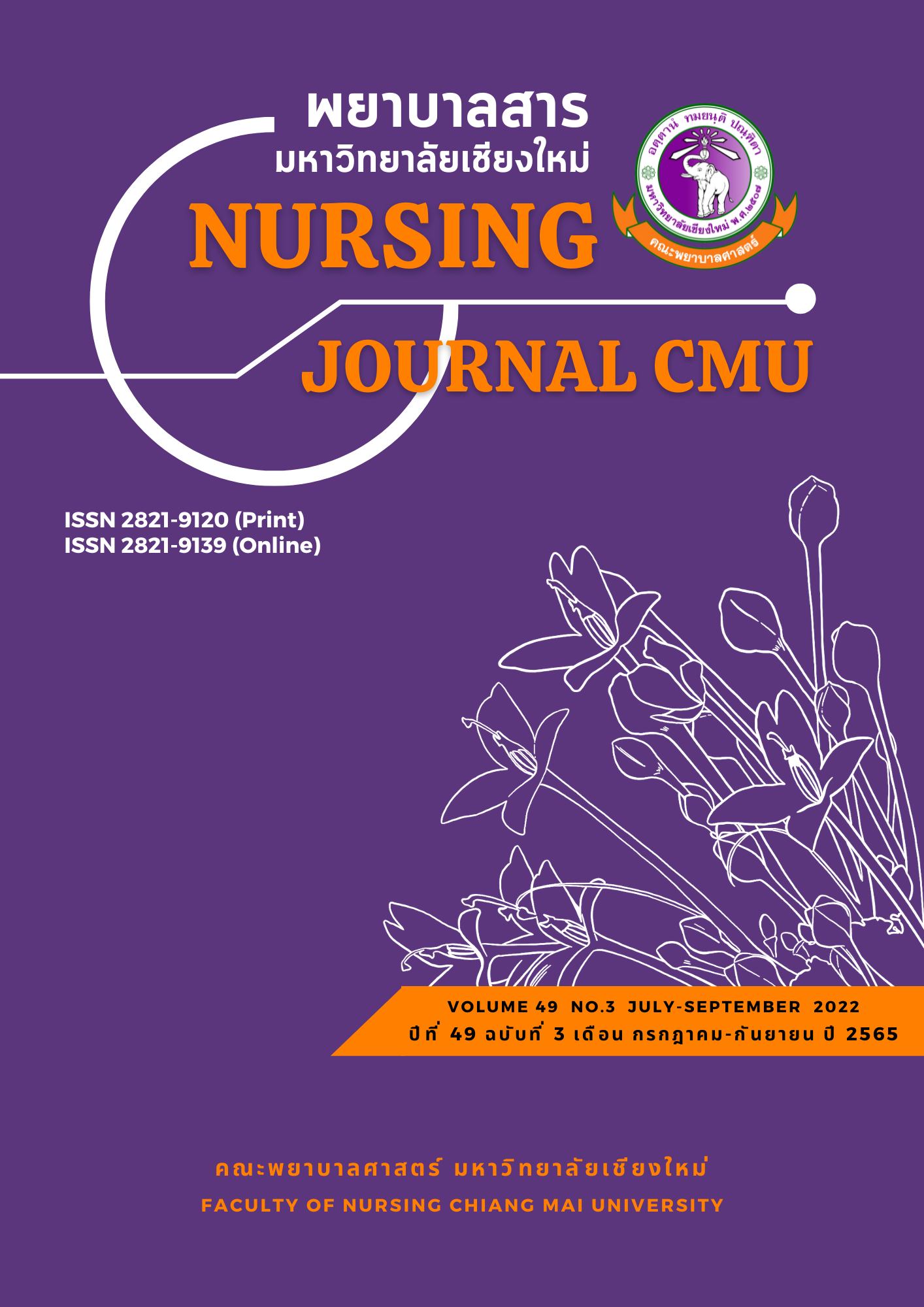การเฝ้าติดตามระยะก่อนการเกิดภาวะหัวใจหยุดเต้นและภาวะหยุดหายใจ และระหว่างการปฏิบัติการช่วยชีวิตของพยาบาลที่แผนกอุบัติเหตุฉุกเฉิน
คำสำคัญ:
การเฝ้าติดตาม, การเกิดภาวะหัวใจหยุดเต้นและภาวะหยุดหายใจ, แผนกอุบัติเหตุและฉุกเฉินบทคัดย่อ
การเฝ้าติดตามผู้ป่วยที่ถูกต้องและเหมาะสมในแผนกอุบัติเหตุฉุกเฉินมีความสำคัญอย่างยิ่ง ที่จะทำให้พยาบาลสามารถทราบอาการที่เปลี่ยนแปลงของผู้ป่วยได้ทันการณ์ ส่งผลให้ผู้ป่วยได้รับการรักษาอย่างทันท่วงที การวิจัยเชิงพรรณนาแบบย้อนหลังครั้งนี้ มีวัตถุประสงค์เพื่อศึกษาการเฝ้าติดตามในระยะก่อนการเกิดภาวะหัวใจหยุดเต้นและภาวะหยุดหายใจ และระหว่างการปฏิบัติการช่วยชีวิตของพยาบาลที่แผนกอุบัติเหตุฉุกเฉิน กลุ่มตัวอย่างคือข้อมูลจากเวชระเบียนของผู้ป่วยฉุกเฉินวิกฤตที่ได้รับการปฏิบัติการช่วยชีวิตที่แผนกอุบัติเหตุฉุกเฉิน จำนวน 92 ราย เครื่องมือที่ใช้ในการวิจัยครั้งนี้เป็นแบบรวบรวมข้อมูลการเฝ้าติดตามระยะก่อนการเกิดภาวะหัวใจหยุดเต้นและภาวะหยุดหายใจ และระหว่างการปฏิบัติการช่วยชีวิตของพยาบาลที่แผนกอุบัติเหตุฉุกเฉิน ซึ่งผู้วิจัยได้สร้างขึ้นมาจากแนวคิดของ โพทิทาคิส และคณะ (Pothitakis et al., 2011) ร่วมกับการทบทวนวรรณกรรม ผ่านการตรวจความตรงตามเนื้อหาโดยผู้ทรงคุณวุฒิจำนวน 5 คน และผ่านการตรวจสอบความตรงของการบันทึกระหว่างผู้วิจัยกับผู้ทรงคุณวุฒิ (inter-rater reliability) ได้ความตรงของการบันทึกเท่ากับ 1.00 วิเคราะห์ข้อมูลโดยใช้สถิติเชิงพรรณนา
ผลการวิจัยพบว่าการเฝ้าติดตามในระยะก่อนการเกิดภาวะหัวใจหยุดเต้นและภาวะหยุดหายใจเป็นไปตามเกณฑ์เพียงร้อยละ 17.40 การเฝ้าติดตามระหว่างการปฏิบัติการช่วยชีวิตไม่มีกลุ่มตัวอย่างได้รับการเฝ้าติดตามเป็นไปตามเกณฑ์
ผลการวิจัยครั้งนี้แสดงให้เห็นถึงความจำเป็นในการพัฒนาการเฝ้าติดตามผู้ป่วยฉุกเฉินวิกฤตของพยาบาลในหน่วยงานอุบัติเหตุฉุกเฉิน การเฝ้าติดตามผู้ป่วยอย่างถูกต้องและเหมาะสมจะช่วยให้พยาบาลสามารถให้การดูแลผู้ป่วยอย่างมีคุณภาพ
เอกสารอ้างอิง
Adane, K., Muluye, D. & Abebe, M. (2013). Processing medical data: A systematic review. Archives of Public Health, 71(27), 1-6. doi:10.1186/0778-7367-71-27
Agency for Health Care Research and Quality. (2011). Emergency Severity Index (ESI) a triage tool for emergency department care version 4 implementation handbook. Gaither Road Rockville, MD: Author.
Agency for Health Care Research and Quality. (2014). Early warning scoring system proactively identifies patients at risk of deterioration, leading to fewer cardiopulmonary emergencies and deaths. Retrieved from http://www.innovations.ahrg.gov/content.aspx?id=2607
American Heart Association. (2014). About cardiac arrest. Retrieved from http://www.heart.org/HEARTORG/Conditions/More/CardiacArrest/About-Cardiac-Arrest_UCM_307905_Article.jsp
Australian Resuscitation Council & New Zealand Resuscitation Council. (2011). Protocols for adult advance life support. ARC and NZRC guideline 2010. Emergency Medicine Australasia, 23(3), 271-274. doi: 10.1111/j.1742-6723.2011.01422_10.x
Bortle, C. D. & Levitan, R. (2016). Overview of respiratory arrest. Retrieved fromhttp://www.merckmanuals.com/professional/critical-care-medicine/ respiratory-arrest/overview-of-respiratory-arrest
Canadian Association of Emergency Physicians – CAEP. (2014). Implementationguidelines. Retrieved from http://caep.ca/resources/ctas/implementation-guidelines#goals-of-triage
Deakin, C. D., Nolan, J. P., Soar, J., Sunde, K., Koster, R. W., Smith, G. B., & Perkins, G. D. (2010). European resuscitation council guidelines for resuscitation 2010 Section 4: Adult advance life support. Resuscitation, 81(10), 1305-1352. doi: 10.1016/j.resuscitation.2010.08.017
Howes, D., Gray, H. S., Brooks, C. S., Boyd, G. J., Djogovic, D., Golan, E., … Muscedere, J. (2016). Canadian guidelines for the use of targeted temperature management (therapeutic hypothermia) after cardiac arrest: A joint statement from the Canadian Critical Care Society (CCCS), Canadian Neurocritical Care Society (CNCCS), and the Canadian Critical Care Trials Group (CCCTG). Resuscitation, 98, 48–63. doi:10.1016/j.resuscitation.2015.07.052
Institute for Healthcare Improvement. (2014). Early warning systems: Scorecards that save lives. Retrieved from http://www.ihi.org/resources/Pages/ImprovementStories/EarlyWarningSystemsScorecardsThatSaveLives.aspx
Johnson, K. D., Winkelman, C., Burant, C. J., Dolansky, M., & Totten, V. (2014). The factors that affect the frequency of vital sign monitoring in the emergency department. Journal of Emergency Nursing, 40(1), 27-35. doi: org/10.1016/j.jen.2012.07.023
Källberg, A, Göransson A. C. E. K., Florin d. J., Östergren, J., Brixey, J. J., & Ehrenberg, A. (2015). Contributing factors to errors in Swedish emergency departments. International Emergency Nursing, 23, 156–161. doi: org/10.1016/j.ienj.2014.10.002
Kernan, W. N., Ovbiagele, B., Black, H. R., Bravata, D. M., Chimowitz, M. I., Ezekowitz, M. D., … Wilson, J. A. (2014). Guidelines for the prevention of stroke in patients with stroke and transient ischemic attack a guideline for healthcare professionals from the American Heart Association/American Stroke Association. Stroke, 45(7), doi:10.1161/STR.0000000000000024
Kyriacos, U., Jelsma, J., James, M., & Jordan, S. (2014). Monitoring vital signs: Development of a modified early warning scoring (Mews) system for general wards in a developing country. PLOS one, 9(1), 1-10. doi: 10.1371/journal.pone.0087073
Linden, M., C, Barbara, E. A, M. & van der Linden N. (2016). Emergency department crowding affects triage processes. International Emergency Nursing, 29, 27–31. doi: org/10.1016/j.ienj.2016.02.003
Neumar, R. W., Otto, C. W., Link, M. S., Kronick, S. L., Shuster, M., Callaway, C. W., … Morrison, L. J. (2010). Part 8: Adult advanced cardiovascular life support: 2010 American Heart Association Guidelines for cardiopulmonary resuscitation and emergency cardiovascular care. Circulation, 122(18 Suppl 3), s729-s767.doi:10.1161/CIRCULATIONAHA.110.970988
Patocka, C., Turner, J., Xue, X., & Segal, E. (2014). Evaluation of an Emergency Department Triage Screening Tool for suspected severe sepsis and septic shock. Journal for Healthcare Quality, 36, 52-61.
Peberdy, M. A., callaway, C. W., Neumar, R. W., Geocadin, R. G., Zimmerman, J. L., Donnino, M., … Kronick, S. L. (2010). Part 9: Post-cardiac arrest care: 2010 American Heart Association Guidelines for cardiopulmonary resuscitation and emergency cardiovascular care. Circulation, 122(18 Suppl 3), s768-s786. doi: 10.1161/CIRCULATIONAHA.110.971002
Pothitakis, C., Ekmektzoglou, K. A., Piagkou, M., Karatzas, T., & Xanthos, T. (2011). Nursing role in monitoring during cardiopulmonary resuscitation and in the peri-arrest period: A review. Heart & Lung, 40(6), 530-544. doi: 10.1016/j.hrtlng.2010.11.006
Roffi, M., Patrono, C., Collet, J., Mueller, C., Valgimigli, M., Andreotti, F., … Windecker, S. (2016). 2015 ESC Guidelines for the management of acute coronary syndromes in patients presenting without persistent ST-segment elevation. European Heart Journal, 37(3), 267–315. doi: 10.1093/eurheartj/ehv320
Smith, G. B. (2010). In-hospital cardiac arrest: Is it time for an in-hospital ‘chain of prevention? Resuscitation, 81(9), 1209-1211. doi: 10.1016/j.resuscitation.2010.04.017
Travers, H. A., Rea, D. T., Bobrow, J. B., Edelson, J. B., Berg, P. D., Sayre, R. M., … Swor, A. R. (2010). Part 4: CPR overview: 2010 American Heart Association Guideline for cardiopulmonary resuscitation and emergency cardiovascular care. Circulation, 122(18 Suppl 3), S676-s684. doi: 10.1161/CIRCULATIONAHA.110.970913
Thana, K., & Klunklin, A. (2015). Nursing documentation: The nurses’ most importantevidence. Nursing Journal, 42(1), 164-170.
ดาวน์โหลด
เผยแพร่แล้ว
รูปแบบการอ้างอิง
ฉบับ
ประเภทบทความ
สัญญาอนุญาต
ลิขสิทธิ์ (c) 2022 พยาบาลสาร

อนุญาตภายใต้เงื่อนไข Creative Commons Attribution-NonCommercial-NoDerivatives 4.0 International License.
บทความที่ได้รับการตีพิมพ์เป็นลิขสิทธิ์ของวารสารพยาบาลสาร
ข้อความที่ปรากฏในบทความแต่ละเรื่องในวารสารวิชาการเล่มนี้เป็นความคิดเห็นส่วนตัวของผู้เขียนแต่ละท่านไม่เกี่ยวข้องกับมหาวิทยาลัยเชียงใหม่ และคณาจารย์ท่านอื่นๆในมหาวิทยาลัยฯ แต่อย่างใด ความรับผิดชอบองค์ประกอบทั้งหมดของบทความแต่ละเรื่องเป็นของผู้เขียนแต่ละท่าน หากมีความผิดพลาดใด ๆ ผู้เขียนแต่ละท่านจะรับผิดชอบบทความของตนเองแต่ผู้เดียว






